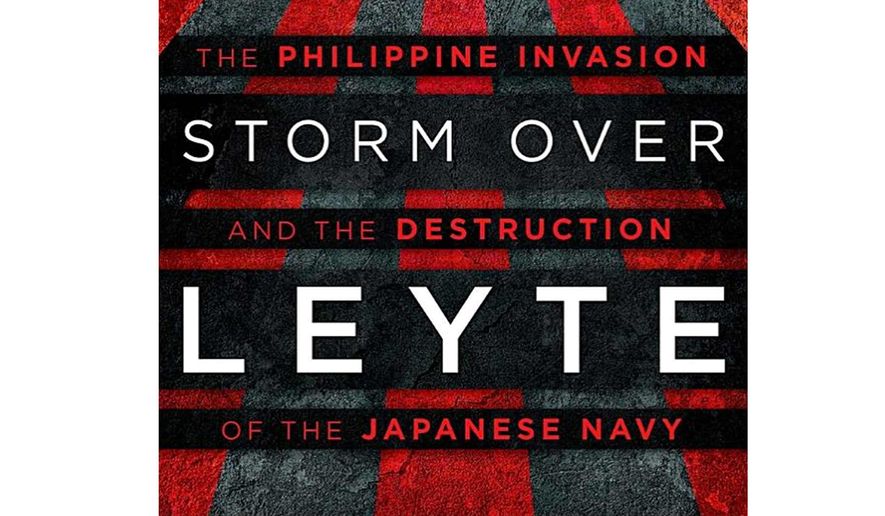OPINION:
STORM OVER LEYTE: THE PHILIPPINE INVASION AND THE DESTRUCTION OF THE JAPANESE NAVY
By John Prados
NAL Caliber, $28, 400 pages
I didn’t much care for John Prados’ “Vietnam: An Unwinnable War,” from the title on down. I haven’t read the anti-Vietnam War activist’s books on the CIA, but a friend who is most knowledgeable on intelligence matters called these books “rather foolish.”
Yet I tackled Mr. Prados’ latest book, “Storm Over Leyte: The Philippine Invasion and the Destruction of the Japanese Navy,” as I have a strong interest in the October 1944 Battle of Leyte Gulf, an engagement that has been called the largest and perhaps the greatest naval battle in history. I’m also interested in the naval battle as my late father, a U.S. Navy UDT frogman, participated in the invasion of the Philippines.
Other historians have covered this famous battle extensively in their books, including Samuel Elliot Morison and John Toland, but Mr. Prados provides the most up-to-date information from diaries, recently released government documents, declassified intelligence reports, and postwar interrogation transcripts.
He also offers more information than most books on the key role of intelligence in the battle. I found his passages on the Joint Intelligence Center Pacific Ocean Area (JICPOA), called the “Zoo,” the Fleet Radio Unit Pacific (FRUPAC), and other intelligence units to be most interesting.
“The focus here on intelligence opened the door to a huge array of information that was unknown or poorly understood. That carried us a considerable way towards providing a fresh view of this crucial battle,” Mr. Prados writes.
The heroes of the sea battle are the gallant and bold sailors and pilots who fought on aircraft carriers and other ships, but this book also offers the contributions of unsung heroes — the intelligence officers, Japanese linguists, cryptologists and radiomen who provided the American commanders with critical information about the Japanese Navy.
“The Battle of Leyte Gulf figures among the most important events of the Pacific campaign in World War II. As a turning point it marked a key passage of the war. As a crushing blow to Japanese power it brought an escalation of violence that led to some of the bloodiest confrontations of the war,” Mr. Prados writes in his introduction to the book. “Though Leyte Gulf is among the more studied clashes of the fight, it still offers space for fruitful exploration.”
Mr. Prados calls the book “big-picture military history.”
The book opens with a dramatic meeting in Pearl Harbor in July 1944. President Franklin Delano Roosevelt had traveled to Hawaii as a passenger onboard the heavy cruiser USS Baltimore. At Pearl Harbor he met in conference with Gen. Douglas A. MacArthur and Adm. Chester W. Nimitz.
The men met to discuss two strategic visions. One was to leap from the Marianas to Taiwan, cutting off Japan’s supply lines, which would include practically all of the fuel the Japanese military needed to operate. The other vision was to jump to the Philippines.
“This would succor Filipino partisans, who had been fighting the Japanese for many long years, and liberate a land in which the United States had a direct interest. The islands also offered airfields and an invasion platform, though less centrally located,” Mr. Prados explains. “A Philippine invasion would make good on the American promise during the dark early days of the war, articulated by none other than Douglas MacArthur, to free the islands from Japanese occupiers.”
And so it was on to the Philippines.
Mr. Prados offers a good blow-by-blow account of the great naval battle. He also offers good portrayals of the legendary senior military men who participated in the battle, such as Adm. William “Bull” Halsey, as well as some lessor known and more junior sailors and airmen. He does not neglect the other side, and the book offers good portraits of the Japanese commanders. Mr. Prados’ narrative builds up to the battle, chronicling the decision-making process, the plans and the tactics of the major participants.
Also of interest is Mr. Prados’ coverage of the Japanese Navy’s use of a “kamikaze” force in the battle. Mr. Prados explains that Vice Adm. Onishi Takijiro had a willingness to embrace new thinking.
“Such was the case with “body-crashing” (tai-atari) tactics — the notion of using the aircraft itself a weapon. JNAF pilots had long since come to the idea of perishing in crash-dives when they were wounded or their planes so damaged that survival seemed impossible,” Mr. Prados writes. “The new wrinkle was to make tai-atari the normal, standard tactic, and to create whole units — a “special attack” (or kamikaze) force — to carry them out.”
“Storm Over Leyte” is a well-researched and insightful book that students of military history will enjoy.
• Paul Davis, a Navy veteran who served on an aircraft carrier during the Vietnam War, is a writer who covers crime, espionage, terrorism and the military.




Please read our comment policy before commenting.